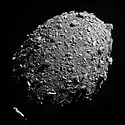 Radar images of 1989 JA and its satellite, imaged by the Goldstone observatory in May 2022 | |
| Discovery[1] | |
|---|---|
| Discovered by | E. F. Helin |
| Discovery site | Palomar Obs. |
| Discovery date | 1 May 1989 |
| Designations | |
| (7335) 1989 JA | |
| 1989 JA | |
| Apollo · NEO · PHA[1] | |
| Orbital characteristics[1] | |
| Epoch 4 September 2017 (JD 2458000.5) | |
| Uncertainty parameter 0 | |
| Observation arc | 27.98 yr (10,221 days) |
| Aphelion | 2.6277 AU |
| Perihelion | 0.9136 AU |
| 1.7706 AU | |
| Eccentricity | 0.4840 |
| 2.36 yr (861 days) | |
| 341.87° | |
| 0° 25m 5.88s / day | |
| Inclination | 15.196° |
| 61.325° | |
| 232.24° | |
| Earth MOID | 0.0225 AU · 8.8 LD |
| Physical characteristics | |
| Dimensions | 0.932±0.153 km[2] 1.18 km (calculated)[3] 1.8 km (outdated)[1] |
| <12 h[4] | |
| 0.20 (assumed)[3] 0.31±0.30[3][5] 0.322±0.150[2][6] | |
| S[3] | |
| 17.0[1][2][3] · 17.8±0.3[7] | |
(7335) 1989 JA, provisional designation 1989 JA, is a stony asteroid of the Apollo group, classified as near-Earth object and potentially hazardous asteroid, approximately 1 kilometer in diameter. It was discovered on 1 May 1989, by American astronomer Eleanor Helin at the U.S. Palomar Observatory in California.[8] On 27 May 2022, the asteroid made a close approach 0.027 astronomical units (4.0×106 km; 2.5×106 mi) from Earth. During the close approach, optical observations detected signs of an orbiting satellite, which was later confirmed by radar imaging at NASA's Goldstone Solar System Radar in California.[9]
| Date | JPL SBDB nominal geocentric distance |
uncertainty region (3-sigma) |
|---|---|---|
| 2022-05-27 | 4024703 km | ± 153 km |
Orbit and classification
The S-type asteroid orbits the Sun at a distance of 0.9–2.6 AU once every 2 years and 4 months (861 days). Its orbit has an eccentricity of 0.48 and an inclination of 15° with respect to the ecliptic.[1] The first observation was made at the discovering observatory in April 1989, extending the asteroid's observation arc by 1 month prior to its discovery observation.[8] It has a minimum orbital intersection distance to Earth of 0.0225 AU (3,370,000 km) which corresponds to 8.8 lunar distances.[1]
Physical characteristics
During its discovery in May 1989, radiometric observations for this asteroid at Arecibo and Goldstone Observatory rendered a rotation period of less than 12 hours (U=n.a.).[4] According to the survey carried out by the NEOWISE mission of NASA's Wide-field Infrared Survey Explorer, the asteroid measures 0.93 kilometers in diameter and its surface has a high albedo of 0.31–0.32,[2][5][6] while the Collaborative Asteroid Lightcurve Link assumes a standard albedo for stony asteroids of 0.20 and calculates a diameter of 1.18 kilometers, based on an absolute magnitude of 17.0.[3]
Naming
As of 2022, 1989 JA remains unnamed.[8]
References
- 1 2 3 4 5 6 7 8 "JPL Small-Body Database Browser: 7335 (1989 JA)" (2017-03-31 last obs.). Jet Propulsion Laboratory. Retrieved 26 May 2017.
- 1 2 3 4 Mainzer, A.; Grav, T.; Masiero, J.; Hand, E.; Bauer, J.; Tholen, D.; et al. (November 2011). "NEOWISE Studies of Spectrophotometrically Classified Asteroids: Preliminary Results". The Astrophysical Journal. 741 (2): 25. arXiv:1109.6407. Bibcode:2011ApJ...741...90M. doi:10.1088/0004-637X/741/2/90.
- 1 2 3 4 5 6 "LCDB Data for (7335)". Asteroid Lightcurve Database (LCDB). Retrieved 26 September 2016.
- 1 2 Mahapatra, Pravas R.; Benner, Lance A. M.; Ostro, Steven J.; Jurgens, Raymond F.; Giorgini, Jon D.; Yeomans, Donald K.; et al. (March 2002). "Radar observations of asteroid 7335 ( 1989 JA)". Planetary and Space Science. 50 (3): 257–260. Bibcode:2002P&SS...50..257M. doi:10.1016/S0032-0633(02)00002-8. Retrieved 26 September 2016.
- 1 2 Mainzer, A.; Grav, T.; Masiero, J.; Bauer, J.; Wright, E.; Cutri, R. M.; et al. (August 2011). "Thermal Model Calibration for Minor Planets Observed with Wide-field Infrared Survey Explorer/NEOWISE". The Astrophysical Journal. 736 (2): 9. Bibcode:2011ApJ...736..100M. CiteSeerX 10.1.1.472.4936. doi:10.1088/0004-637X/736/2/100. Retrieved 26 September 2016.
- 1 2 Mainzer, A.; Grav, T.; Bauer, J.; Masiero, J.; McMillan, R. S.; Cutri, R. M.; et al. (December 2011). "NEOWISE Observations of Near-Earth Objects: Preliminary Results". The Astrophysical Journal. 743 (2): 17. arXiv:1109.6400. Bibcode:2011ApJ...743..156M. doi:10.1088/0004-637X/743/2/156. Retrieved 26 September 2016.
- ↑ Wisniewski, W. Z.; Michalowski, T. M.; Harris, A. W.; McMillan, R. S. (March 1995). "Photoelectric Observations of 125 Asteroids". Abstracts of the Lunar and Planetary Science Conference. 26: 1511. Bibcode:1995LPI....26.1511W. Retrieved 26 September 2016.
- 1 2 3 "7335 (1989 JA)". Minor Planet Center. Retrieved 26 September 2016.
- ↑ Benner, Lance A. M. "Goldstone Radar Observations Planning: (7335) 1989 JA, 388945 2008 TZ3, and 467460 2006 JF42". Asteroid Radar Research. Jet Propulsion Laboratory. Retrieved 15 June 2022.
External links
- Asteroid Lightcurve Database (LCDB), query form (info Archived 16 December 2017 at the Wayback Machine)
- Dictionary of Minor Planet Names, Google books
- Asteroids and comets rotation curves, CdR – Observatoire de Genève, Raoul Behrend
- (7335) 1989 JA at NeoDyS-2, Near Earth Objects—Dynamic Site
- (7335) 1989 JA at ESA–space situational awareness
- (7335) 1989 JA at the JPL Small-Body Database

